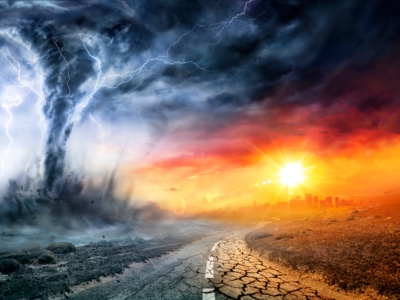
Fall 2023
Climate Change Brings More Extreme Weather Events: What Does That Mean for Youth and Families?
Annette M. La Greca, PhD1; Evan T. Burdette, MS1; & the Climate Change and Health SIG
Climate-related Disasters, Evacuation Stressors, And Health
Climate change is bringing about more extreme weather events (hurricanes, wildfires, tornadoes, floods) in the U.S. and worldwide. Climate-related disasters, such as hurricanes, can have a devastating impact on youth and parents, who have been identified as vulnerable populations in disasters (Norris et al., 2002). Not only do these extreme climate-related events have the potential to affect families’ and youths’ physical and mental health, but the evacuation process itself brings significant stressors that are associated with psychological distress and physical health problems, regardless of whether the disaster actually strikes.
For instance, in 2017, Hurricane Irma led to one of the largest mass evacuations in US history, with nearly 7 million FL residents evacuating their homes for safety (Allen, 2018). Parents residing in southern FL reported significant stressors occurring “before the storm”, which were associated with parents’ and youths’ symptoms of posttraumatic stress, anxiety, and depression as well as with mothers’ and youths’ physical health problems several months later (La Greca et al., 2019, 2022, 2023). Moreover, lower-income families reported greater evacuation stress and had a harder time recovering after the disaster than did higher-income families.
Threats of Disaster are Common
Importantly, threats of disaster occur more frequently than disasters themselves. At present, large segments of the U.S. population are at risk for experiencing a major hurricane, storm surge, or flood. Even if a potentially life-threatening storm does not ultimately make landfall, the uncertainty around hurricane forecasting means that large segments of the population may be in harm’s way and need to evacuate for safety. Similar concerns exist for wildfires and tornadoes.
What does this mean for youth and families? And how can health psychologists and behavioral scientists help?
Promote Coping Even Before A Disaster Strikes
First and foremost, parents and youth need preparedness strategies that not only address families’ physical safety, but also strategies for managing the anticipatory anxiety, fear, and panic associated with impending disasters. Currently, the volume of disaster-preparedness information available is substantial and overwhelming; and preparedness materials largely neglect stress-management and mental health issues. Methods proven successful for preparing youth and families for stressful medical procedures, such as coping-skills training, relaxation, distraction, and modeling calm behavior, might be adapted for the disaster-preparedness context. Accordingly, my lab is developing a Before the Storm adaptation of our widely disseminated After the Storm manual (La Greca et al., 2018) to promote coping even before a disaster strikes. Once youth and families are prepared in terms of physical safety, it is important to encourage family activities that promote relaxation (e.g., deep breathing, mindfulness, exercise) and positive coping.
Second, systematic efforts to encourage uptake of preparedness materials is needed. For example, Family Disaster Plans (Ready.gov, 2023) along with stress-management strategies could be distributed in medical, school, and community settings, to coincide with key times for potential climate events (e.g., spring for tornadoes; summer for wildfires, hurricanes and floods). Youth-oriented materials could also be disseminated at the beginning of the school year in areas vulnerable to extreme weather events. Such efforts would reduce the stress of last-minute decision-making, anxiety, and fear.
When it comes to climate-change, an “ounce of prevention is worth a pound of cure.” Let’s facilitate youth and family coping even before a disaster strikes.
Affiliations
- University of Miami Department of Psychology
References
- Allen, G. (2018, June 1). Lessons from hurricane Irma: When to evacuate and when to shelter in place. NPR. https://www.npr.org/2018/06/01/615293318/lessons-from-hurricane-irma-when-to-evacuate-and-when-to-shelter-in-place
- La Greca, A. M., Brodar, K. E., Danzi, B. A., Tarlow, N., Silva, K., & Comer, J. S. (2019). Before the storm: Stressors associated with the hurricane Irma evacuation process for families. Disaster Medicine and Public Health Preparedness, 13(1), 63–73. https://doi.org/10.1017/dmp.2019.9
- La Greca, A. M., Brodar, K. E., Tarlow, N., & Burdette, E. (2022). Evacuation- and hurricane-related experiences, emotional distress, and their associations with mothers’ health risk behaviors. Health Psychology, 41(7), 443–454. https://doi.org/10.1037/hea0001202
- La Greca, A. M., Burdette, E. T., & Brodar, K. E. (2023). Climate change and extreme weather disasters: Evacuation stress is associated with youths’ somatic complaints. Frontiers in Psychology, 14, 1196419. https://doi.org/10.3389/fpsyg.2023.1196419
- La Greca, A. M., Sevin, S. W., & Sevin, E. L. (2018). After the Storm: A guide to helping children cope with the aftermath of hurricanes. Revised. 7-Dippity, Inc., Miami, FL. www.7-dippity.com
- Norris, F. H., Friedman, M. J., Watson, P. J., Byrne, C. M., Diaz, E., & Kaniasty, K. (2002). 60,000 disaster victims speak: Part I. An empirical review of the empirical literature, 1981–2001. Psychiatry: Interpersonal and Biological Processes, 65(3), 207–239.
- Ready.gov (2023). Make a Plan. U.S. Department of Homeland Security. Retrieved from: https://www.ready.gov/plan
